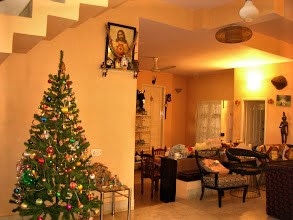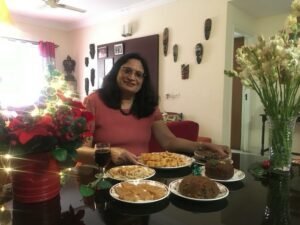Author and former KGF resident Bridget-White Kumar steps back in time to offer a platter of Anglo-traditions, treats and tables during Christmas
Published Dec 25, 2023 | 9:00 AM ⚊ Updated Dec 25, 2023 | 9:00 AM

With the dwindling number of Anglo-Indian families and their traditional recipes, Bridget White-Kumar has been committed to the cause of reviving forgotten dishes of the colonial Raj era. (iStock)
Seventy-one-year-old Bengaluru resident Bridget White-Kumar’s Christmas memory of KGF life in the 50s is tinted in gold. There was abundance in relationships. Secular living was in practice and not on paper. And, the communal style of eating carried with it a sense of civility in that colonial ambience.
Kumar, an Anglo-Indian, was born and raised in KGF, a gold-mining town in Karnataka. The company was earlier owned by a British mining firm called John Taylor and Sons. It was an era when different European ethnicities in the region intermingled with the locals, resulting in marriages and eventually leading to the expansion of the Anglo-Indian community.
Later in 1957, when the mines were nationalised, the Europeans went back and the Indian government took over. But KGF continued to be home for the Anglo-Indians. Four generations of Kumar’s family lived and worked in the gold mines.
This Christmas, the former KGF resident pauses time to revisit her memories of the holiday season when the times were simpler but celebrations were a font of conviviality.
In the December of the 50s and 60s, KGF hummed with guitars, laughter, and carolling. KGF had four mines, and each mine had its Christmas tree, shares Kumar, who belonged to the Nundydroog Mine.
Kumar, her cousins and friends eagerly waited for the annual sports event which was held days before Christmas.

A fortnight before Christmas, Kumar’s mother would start the preparation of traditional sweets. (Supplied)
“This would be followed by Christmas Tea for children. But the highlight of Sports Day was the arrival of Santa and the gifts he gave away. December in KGF was carnival time,” she recalls.
A funfair was also held in the compound of the Skating Rink simultaneously, which had games like The Lucky Arrow, Ringing the Bottle, Skittles, Ringing the Duck, Belling the Cat, Pinning the tail on the Donkey etc.
Here, Kumar’s father would buy them tickets and they’d try their fortunes at all the stalls. The air in KGF would be filled with screams of joy if they won cakes of soap, bottles of jam and tomato sauce etc. as prizes on the Lucky Arrow, and in the Lucky Dip.
“Sometimes we would land up with almost 20 bottles of jam or tomato ketchup that all of us won at the Lucky Arrow,” she remembers.
The month of December also meant regular visits to Eashwar Rao, who was also known as Pansy Tailor, to get their Christmas clothes tailored. Kumar had three new dresses for the season — one for the Nundydroog Mine Christmas Tree Function, one for Christmas Day and one for New Year day.
“Sometimes our parents made a trip to Bengaluru to buy the material for our Christmas dresses from Fazals and Adam Sait Stores and our shoes from Reliance Shoe Shop all on Commercial Street,” she recalls.
Their Christmas shoes would usually be a white pair to match their new frocks.
“In case they couldn’t go to Bengaluru, then we would go shopping in our market in Robertsonpet Town and buy from Mohanlal, Sohans, Bhora and some other shops,” she shares.
Pansy Tailor was the most sought-after tailor for women in KGF, she mentions. He was always buried under stitching orders this time of the year, by almost all the Anglo-Indians in KGF.
“He warned all his customers to bring him their Christmas tailoring orders before the middle of November so that he was able to plan his schedule,” she adds.
A fortnight before Christmas, Kumar’s mother would start the preparation of traditional sweets. Kulkuls, rose cookies, fruit cakes, coconut sweets, Christmas pudding, dodol, beveca, marzipan sweets, peanut fudge, cashewnut fudge, rice crispies, and athirasam were the usual suspects.
“We’d all sit around the dining table and each of us would take a lump of dough and spread it on a fork to make as many kulkuls as possible with it. These kulkuls were like small shells. To make other shapes, we would also roll out the dough and cut out various shapes like hearts, clubs, diamonds, etc with the cutters. It was fun competing with each other to see who made the most,” she shares.
Dodol (a black rice halwa) needed more than three hours to prepare and had to be stirred constantly. The entire family would take turns to stir the gooey mixture till it reached the right consistency. Making coconut sweets was another treat.
“All of us would fight to scrape the residue left over in the pan,” she says.
Like most family celebrations, Kumar’s too centred around food. The kitchen had an unstoppable stream of traditional delicacies at this time of the year. The day before Christmas, Kumar’s home kitchen would be loud with the clank of vessels.
Her grandmother would place a huge pot on firewood to cook her signature stew made of different types of meat — pork, mutton, beef, and chicken.
After church on the night before Christmas, the family would gather for stew, cake and wine. “On the morning of Christmas, we would wake up excitedly to find our gifts under the Christmas tree,” she shares.
“Our food habits were greatly influenced by the British because everything was specially imported by the management to the English Warehouse and Spencers store,” she shares.
Kumar’s grandmother was meticulous with the Christmas table decor. All the fancy Christmas-themed tablecloths with matching serviettes would be brought out. Most of these were embroidered by her grandmother, who ensured the table was always laid and set well with appropriate cutlery and crockery.

After church on the night before Christmas, the family would gather for stew, cake and wine. (Supplied)
On the morning of Christmas, Kumar and her cousins would surrender to the deliciousness of anticipation of the enormous English breakfast. “Fried eggs, scrambled eggs, toast, pancakes, bacon sausages were all staples,” she reveals.
Lunch was more elaborate. “Grandmother usually prepared coloured rice like the yellow coconut rice, or pilaf. Often, pilaf is mistaken for biryani. But, biryani has a different process of cooking. Our lunch table would be a spread of pork vindaloo, chicken fry, chicken vindaloo and sometimes, duck,” she details. Besides this, her grandmother would place cold cuts spread and a cheese board on the table. The latter was the centrepiece, Kumar adds.
The heavy scents of turkey dominated their dinner table which was surrounded by her uncles, aunts, cousins, grandaunts and granduncles.
One huge turkey would be cooked from the morning hours to ensure it’s tender by dinner time. Later, it would be roasted and stuffed using her grandmother’s unique recipe. Sweets and wine followed in plenty.
“Children would always sit down for dinner first. My aunts would hover around and my grandmother would sit with us, forcing us to eat more,” she laughs.
Now, the tables have shrunk and so have the number of people around the table. Kumar attempts to continue some traditions, but not all. She now makes stew which has only chicken.
Kumar is also aware that health is everyone’s priority. Tastes have changed, she informs. “Most people prefer ordering in biryani.”
After the passing of her husband, and two years of Covid-19, Kumar found it wise to downsize. She gave away her big Christmas tree and two boxes full of decorations that Kumar had gathered over 40 years. “Now I have a 2-ft Christmas tree and a small crib that I put on the table,” she discloses.
She’s also aware that families have become smaller with children leaving their proverbial nest. Christmas preparations need a lot of help, she says. In the absence of this assistance, it has taken a toll on the Christmas table, Kumar states.
This Christmas, Kumar’s daughter and her family will be arriving from Singapore. “We’ll just have a quiet Christmas at home. I have made some cake, rum balls, kulkuls. I intend to make pork vindaloo, pork chops, chicken curry and maybe some veg bake,” she shares.
With the dwindling number of Anglo Indian families and their traditional food fast disappearing, Kumar has been committed to the cause of reviving forgotten dishes of the colonial Raj era. She has authored seven recipe books on Anglo-Indian cuisine as a means to preserve for posterity the very authentic tastes and flavours of Colonial ‘Anglo’ India.
Here’s to Kumar and her ilk for whom Christmas is a many-splendored occasion to this very effort.
